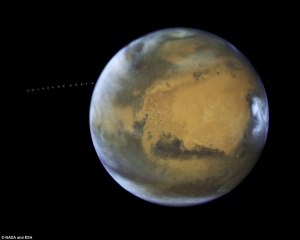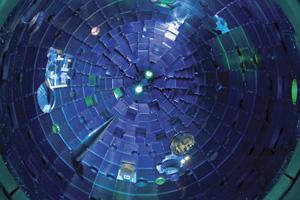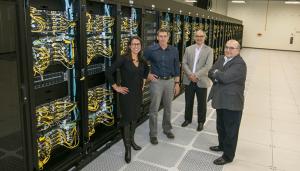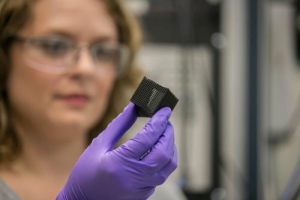LAB REPORT
Science and Technology Making Headlines
Oct. 14, 2016

Researchers have demonstrated how an asteroid or comet could have caused the mega crater on Phobos withoutdestroying the Martian moon.
Death Star moon
Mars' largest satellite, Phobos, looks a bit like the Death Star from the "Star Wars" movies because of a large crater spanning half of its surface. Now scientists have finally found out how Stickney crater was created.
Phobos is one of the most enigmatic natural satellites in the solar system, puzzling scientists for years as they struggled to understand how a 9 km-wide crater could have formed on the surface of the moon, which is only 22 km across, without destroying it.
The latest research, published in Geophysical Research Letters, is based on numerical simulations conducted at Lawrence Livermore National Laboratory.


The National Ignition Facility, shown here, provides opportunities for academic collaborators to utilize the facility. Damien Jennison/LLNL
From weapons to white dwarfs
Weapons labs started designing huge lasers after the Comprehensive Nuclear Test Ban Treaty brought an end to nuclear testing in the mid-1990s. The labs’ scientists ensure the continued safety and reliability of weapons by simulating the behavior of warheads using algorithms run on very powerful supercomputers. But they are unable to calculate opacity, strength and other material properties of the plasma created inside an exploding warhead using algorithms alone, which is why they also need to verify these algorithms experimentally. It is here that the lasers come in.
The National Ignition Facility at Lawrence Livermore National Laboratory is a vast enterprise, its lasers occupying an area equivalent to three football pitches and generating 192 separate beams. These beams are directed by mirrors inside a 10-story structure to the center of a 10 m-diameter aluminum target chamber shielded by concrete. The target usually consists of a centimeter-long hollow gold cylinder containing a plastic-coated, peppercorn-sized sphere of deuterium and tritium nuclei. Laser beams striking the inside of the cylinder create X-rays that crush the sphere and in the process set off a shock wave that heats the nuclei to about 50 million degrees Celsius, so causing them to merge -- a process known as inertial confinement fusion.


By applying HPC to the analysis of medical data, researchers hope to improve screening for cervical cancer.
Leveraging HPC to track cancer
Research teams from Lawrence Livermore National Laboratory (LLNL) and the Cancer Registry of Norway recently combined their efforts to apply high performance computing (HPC) analysis to help improve screenings for cervical cancer.
The LLNL research team said they are partnering to advance precision medicine by developing individually tailored treatment strategies for patients at risk of cervical cancer. Initial research will be focused on enhancing risk assessment strategies and personalized screening recommendations for individual women.
Norway is one of a few nations across the globe that provides guaranteed equal access to health care for all citizens, making their health care registries an important resource for studying women’s cervical cancer screening results. The Norwegian healthcare database covers 25 years worth of cervical cancer screening records with approximately 1.8 million unique results.

Glendon Parker, a biochemist with LLNL’s Forensic Science Center, examines a 250-year-old hair sample. Photo by Julie Russell/LLNL
DNA meets its match
DNA may have met its match when it comes to solving crimes. In the future, it may come down to just a single hair, thanks to work done by scientists at Lawrence Livermore.
A single strand of hair contains a lot of answers, according to the research. Lab scientists have developed a way to identify a person based on the unique pattern of proteins in hair. The new technique may soon help police identify suspects.
Scientists say they’re on the verge of being able to link a single hair to a specific person worldwide.


Lab researcher Jennifer Rodriguez examines a 3D-printed box that was programmed to fold and unfold when heated. Photo by Julie Russell/LLNL
Shape-shifting origami
The concept of 4D printing isn't new, but processes that use new types of environmental stimuli keep appearing. 4D printing is usually defined as 3D printing with materials that change shape in response to light, heat, water, air pressure, or other factors. It usually combines 3D printing with shape-memory materials.
The latest is a new process developed by a team at Lawrence Livermore National Laboratory. Researchers have 3D printed shape-shifting structures that can fold and unfold themselves, or expand and contract in size, when prompted by changes in electricity or heat. The primary shapes they created were printed with shape-memory polymer inks developed by the team using a direct-ink writing 3D printing process.





